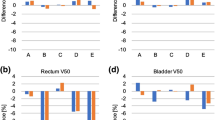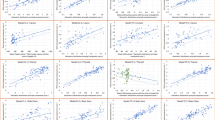Abstract
This study devised a method to efficiently launch the RapidPlan model for volumetric-modulated arc therapy for prostate cancer in small- and medium-sized facilities using high-quality treatment plans with the PlanIQ software as a reference. Treatment plans were generated for 30 patients with prostate cancer to construct the RapidPlan model using PlanIQ as a reference. In the context of PlanIQ-referenced treatment planning, treatment plans were developed, such that the feasibility dose–volume histogram of each organ-at-risk fell within F ≤ 0.1. For validation of the RapidPlan model, treatment plans were formulated for 20 patients using both RapidPlan and PlanIQ, and the differences were evaluated. The results of RapidPlan model validity assessment revealed that the RapidPlan-produced treatment plans exhibited higher quality in 11 of 20 patients. No significant differences were found between the treatment plans. In conclusion, high-quality treatment plans formulated using PlanIQ as reference facilitated efficient implementation of RapidPlan modeling.






Similar content being viewed by others
Data availability
The data in this study are stored in our laboratory and will be shared upon request to the corresponding author.
References
National Cancer Center, Cancer Information Service. https://ganjoho.jp/reg_stat/statistics/data/dl/index.html#a14. Accessed 24 Apr 2023
Giovannucci E, Rimm EB, Colditz GA, Stampfer MJ, Ascherio A, Chute CG, et al. A prospective study of dietary fat and risk of prostate cancer. J Natl Cancer Inst. 1993;85(19):1571–9.
Moraes FY, Siqueira GM, Abreu CE, da Silva JL, Gadia R. Hypofractioned radiotherapy in prostate cancer: is it the next step? Expert Rev Anticancer Ther. 2014;14(11):1271–6.
Quan EM, Li X, Li Y, Wang X, Kudchadker RJ, Johnson JL, et al. A comprehensive comparison of IMRT and VMAT plan quality for prostate cancer treatment. Int J Radiat Oncol Biol Phys. 2012;83(4):1169–78.
Arya R, Goyal H, Naik A, Gurjar OP. A prospective observational study to analyse the influence of bladder and rectal volume changes on prostate radiotherapy using IMRT. Rep Pract Oncol Radiother. 2020;25(3):312–7.
Williams MJ, Bailey M, Forstner D, Metcalfe PE. Multicentre quality assurance of intensity-modulated radiation therapy plans: a precursor to clinical trials. Australas Radiol. 2007;51(5):472–9.
Xu Y, Brovold N, Cyriac J, Bossart E, Padgett K, Butkus M, et al. Assessment of knowledge-based planning for prostate intensity modulated proton therapy. Int J Part Ther. 2021;8(2):62–72.
Hirashima H, Nakamura M, Mukumoto N, Ashida R, Fujii K, Nakamura K, et al. Reducing variability among treatment machines using knowledge-based planning for head and neck, pancreatic, and rectal cancer. J Appl Clin Med Phys. 2021;22(7):245–54.
Fusella M, Scaggion A, Pivato N, Rossato MA, Zorz A, Paiusco M. Efficiently train and validate a RapidPlan model through APQM scoring. Med Phys. 2018;45(6):2611–9.
Perumal B, Sundaresan HE, Ranganathan V, Ramar N, Anto GJ, Meher SR. Evaluation of plan quality improvements in PlanIQ-guided autoplanning. Rep Pract Oncol Radiother. 2019;24(6):533–43.
Sasaki M, Ikushima H, Tominaga M, Kamomae T, Kishi T, Oita M, et al. Dose impact of rectal gas on prostatic IMRT and VMAT. Jpn J Radiol. 2015;33(12):723–33.
Ahmed S, Nelms B, Gintz D, Caudell J, Zhang G, Moros EG, et al. A method for a priori estimation of best feasible DVH for organs-at-risk: validation for head and neck VMAT planning. Med Phys. 2017;44(10):5486–97.
Fried DV, Chera BS, Das SK. Assessment of PlanIQ Feasibility DVH for head and neck treatment planning. J Appl Clin Med Phys. 2017;18(5):245–50.
Shimizu H, Sasaki K, Aoyama T, Iwata T, Kitagawa T, Kodaira T. Lung dose reduction in patients with stage III non-small-cell lung cancer using software that estimates patient-specific dose reduction feasibility. Phys Med. 2021;85:57–62.
Nelms BE, Robinson G, Markham J, Velasco K, Boyd S, Narayan S, et al. Variation in external beam treatment plan quality: an inter-institutional study of planners and planning systems. Pract Radiat Oncol. 2012;2(4):296–305.
Sasaki M, Nakaguuchi Y, Kamomae T, Tsuzuki A, Kobuchi S, Kuwahara K, et al. Analysis of prostate intensity- and volumetric-modulated arc radiation therapy planning quality with PlanIQ™. J Appl Clin Med Phys. 2021;22(4):132–42.
Kang Z, Fu L, Liu J, Shi L, Li Y. A practical method to improve the performance of knowledge-based VMAT planning for endometrial and cervical cancer. Acta Oncol. 2022;61(8):1012–8.
Hussein M, South CP, Barry MA, Adams EJ, Jordan TJ, Stewart AJ, et al. Clinical validation and benchmarking of knowledge-based IMRT and VMAT treatment planning in pelvic anatomy. Radiother Oncol. 2016;120(3):473–9.
Kubo K, Monzen H, Ishii K, Tamura M, Kawamorita R, Sumida I, et al. Dosimetric comparison of RapidPlan and manually optimized plans in volumetric modulated arc therapy for prostate cancer. Phys Med. 2017;44:199–204.
Acknowledgements
The authors would like to thank Editage (www.editage.jp) for English language editing.
Funding
This work was supported in part by the Foundation for Promotion of Cancer Research (2022 General Proposal B).
Author information
Authors and Affiliations
Corresponding author
Ethics declarations
Conflict of interest
Yuji Nakaguchi is an employee of Toyo Medic Co., Ltd.
Ethical approval
All procedures performed in this study were conducted in accordance with the ethical standards of the Institutional Review Board (IRB) and with the 1964 Declaration of Helsinki and its later amendments or comparable ethical standards.
Informed consent
The patients provided informed consent authorizing the use of their personal information for research purposes.
Additional information
Publisher's Note
Springer Nature remains neutral with regard to jurisdictional claims in published maps and institutional affiliations.
About this article
Cite this article
Masumoto, N., Sasaki, M., Nakaguchi, Y. et al. Knowledge-based model building for treatment planning for prostate cancer using commercial treatment planning quality assurance software tools. Radiol Phys Technol 17, 337–345 (2024). https://doi.org/10.1007/s12194-023-00759-6
Received:
Revised:
Accepted:
Published:
Issue Date:
DOI: https://doi.org/10.1007/s12194-023-00759-6




